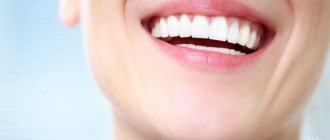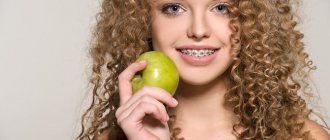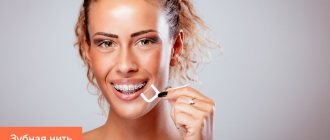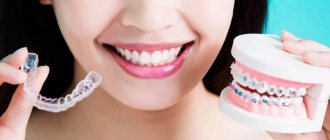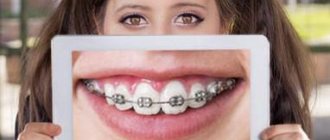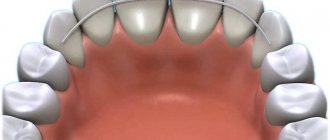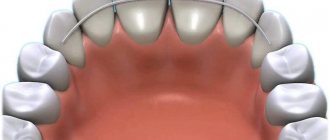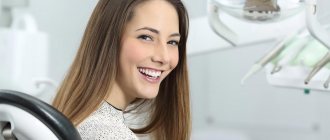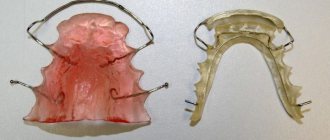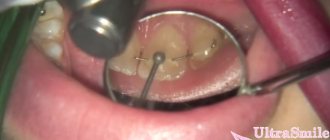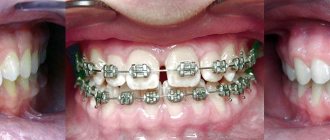Removable structures
Very easy to use, they can be removed independently during meals, hygiene procedures, and if therapeutic dental treatment is necessary. Also easy to install back. There are several types:
- Polymer transparent retainers-aligners, reinforced with a metal arch. They fix the position of the teeth along the length of the jaw and are invisible to others. Used constantly, excluding food intake and care procedures.
- Orthodontic plates consist of a plastic base and fixing metal elements. Basically, the designs are worn at home and put on before bed.
- Positioners keep the teeth in the correct position and restore the tone and density of the gum tissue. Made from elastic polyurethane, they are easy to use and do not cause allergic reactions. Show high effectiveness for minor occlusion disorders.
Removable orthodontic appliances are made within 3-7 days using individual impressions.
The final stage of treatment
Once each tooth has taken its place, therapy cannot be stopped. Indeed, over time, the curvature may develop again, and then all efforts will be useless. It is important to securely fix them in the new position. This is the main purpose of using retention devices. They must be used until the adaptation stage is completed (the period is determined by the doctor). When worn, they are imperceptible and hardly noticeable. It's not difficult to get used to them. Care does not take much time, there is no negative impact on the enamel or gums, and, as practice shows, the result is not long in coming.
Fixed retainers
They are represented by a thin metal arch, which is point-fixed with composite material to the inner surface of each tooth. They are installed immediately after the braces are removed, the adjustment time does not exceed a week. It must be remembered that the results of corrective treatment can only be maintained by constantly wearing retention splints! Neglecting the orthodontist's recommendations leads to deformations of the dentition and bite.
Installation Features
Retainers are installed on the day the braces are removed. Fixation is carried out after polishing the enamel and/or professional hygiene. For better adhesion, a special composition is applied to the surface of the teeth. The installation of removable devices is preceded by taking impressions and making mouth guards, positioners or orthodontic plates in the laboratory.
Instructions for the care and wearing of a removable retention device
- 1. On the first day of wearing a retainer, you may experience slight pain in the area of some teeth. This is a temporary phenomenon that goes away after a few hours.
- 2. In the first days after installing the mouth guard, increased salivation is possible, which goes away after 1-2 days.
- 3. There may be a slight change in diction in the first days after installing the mouth guard. Diction will be fully restored after 2-3 days of regularly wearing the mouth guard.
- 4. If during wearing you notice that the edges of the retainer scratch the mucous membrane of the tongue or cheeks, then in this case you need to contact your doctor to have these sharp edges corrected.
- 5. Under no circumstances should any food be consumed in a removable retainer. This can lead to rapid breakdown of the device.
- 6. You cannot smoke with a mouthguard in your mouth or take coloring liquids (red wine, juices, Coca-Cola, etc.). This may cause the mouthguard to lose its clear properties.
- 7. Do not immerse the mouthguard in hot liquids (more than 40 degrees). This may lead to its deformation.
- 8. In those moments when it is necessary to remove the mouth guard, watch where it is located, because Most often, its loss occurs in cafes, bars and restaurants, during meals.
- 9. When removing the mouthguard, do not put it in your clothing pockets without a special container; if you forget about it, you can easily damage it.
- 10. You need to clean your mouthguard 2 times a day with a toothbrush and soap. You need to be very careful when cleaning. Significant bending of the mouth guard can lead to cracks in it.
- 11. If you have lost your mouth guard, you must urgently make an appointment with a doctor to take impressions and make a new mouth guard. This needs to be done as quickly as possible, because... Without a mouth guard, your teeth can quickly change their position and not for the better.
- 12. If you are far from the clinic, or your doctor is on vacation, other doctors at our clinic, or any dental institution in your place of stay, can take impressions and make plaster models for you.
- 13. The service life of the mouth guard is about 1 year, after which it is necessary to make a new mouth guard. The patient pays for a new mouthguard. In cases where a mouth guard is lost or broken, the patient bears the cost of making a new mouth guard.
PS You may also find it useful to learn how to care for braces.
If you were treated in another clinic, and for some reason you did not have a retention mouthguard installed, and after reading this page you have a desire to maintain the result, then we can make a retention mouthguard for you.
General care recommendations
The retention period is the most important and integral part of the technology for correcting occlusion. The success of treatment largely depends on the patient’s conscientious adherence to the doctor’s recommendations.
- Before fixing them on the teeth, removable retainers are rinsed with a soapy solution; in the morning and before bed, it is recommended to clean them with a special brush with a low-abrasive paste. Once or twice a week, removable structures are soaked in an antibacterial solution. To protect against damage and deformation, tires should be stored in a lockable case.
- Oral care with permanently installed retainers is carried out using traditional methods. For thorough cleaning of mineralized plaque and food debris, threads, brushes, and irrigators are used.
- An indispensable condition for oral health is visiting the orthodontist at least twice a year. An emergency visit to the dentist is necessary in case of discomfort and pain, as well as in case of damage to the aligners, plates or breakage of the metal arch.
Instructions for the care and monitoring of a fixed retention device
- 1. Monitor the integrity of the permanent retainer; periodically check it with your finger in front of a mirror with good lighting. If you feel the retainer moving around any of your teeth, this is a reason to visit your orthodontist. By examining the condition of the retainer in the mirror, you can independently determine the absence of material on one of the teeth, which also requires a slight correction by your doctor.
- 2. In a situation where a non-removable retainer has completely peeled off from all teeth, this is critical and requires an urgent visit to the doctor. If a non-removable retainer comes off completely, it is mandatory to wear a removable retention mouth guard around the clock until you visit a doctor and install the retainer in its original location.
- 3. In no case should you use a toothpick or other objects to pick out food debris from under the retainer; it is more advisable to use a toothbrush.
- 4. Approximately once every 6 months it is necessary to have professional teeth cleaning (if ultrasound is used during cleaning, it is very important that the doctor has sufficient experience working with orthodontic patients). Incorrect operation of the ultrasonic tip in the retainer area can lead to damage to its integrity.
Advantages of the Alfa-Vid clinic
The Alfa-Vid Dental Center invites patients in need of bite correction to a free consultation. At the initial appointment, the doctor will carefully examine the oral cavity and, depending on the clinical case, will offer the best option for retention treatment. We guarantee:
- compliance with international quality and safety standards;
- individual approach;
- comprehensive problem solving.
If necessary, the patient has access to emergency assistance from doctors of related dental specialties (therapist, surgeon, etc.). The clinic is equipped with advanced European-level equipment, and dentists use high-quality materials in their work.
How long does the retention period last?
There is no consensus on this question. Someone says that retention should be the same in time as the active period of treatment lasted. And some also hint at lifelong wearing of retention devices (which, in principle, is hardly feasible, in our opinion).
During a direct examination by a specialist, you will be able to find out your exact diagnosis, as well as receive a referral for diagnosis or a treatment plan.
As for the timing of wearing this or that retainer... It is clearly connected (logically) with the very essence of retention (the process of consolidating the result). And here you need to understand the main thing...
Namely, the use of retention devices alone cannot guarantee the stability (preservation) of the obtained treatment result. The “targeting” of using this or that type of retainer is very important here. Namely, the correspondence of its level to the level of the previously solved problem (treatment). Therefore, the use of, for example, a wire retainer on teeth after treatment with braces does not at all guarantee that the position of the jaws will remain stable. Because Neither braces, nor wire retainer structures after braces are “sharpened” to the “maxillary” level.
Accordingly, a bite that has been corrected with braces for so long may again become incorrect (see Malocclusion). Because, as you know, occlusion is not only the teeth (their closure). And, precisely, and to a greater extent, it is the jaws and other skeletal features of a person (see Causes of malocclusion).
Therefore, to ensure the stability of the achieved result (for example, treatment with braces), it is not enough to simply install a retainer on the teeth and “wear” it. It is necessary to find during diagnosis and eliminate the root cause of each specific anomaly during the active phase of treatment. Whether it is distal occlusion or mesial occlusion. Or an open, cross or deep bite.
Eliminating the cause of the anomaly “at the root” and “breaking” the pathological chain of the mechanism of the occurrence of the anomaly are the main factors in the success of treatment and maintaining the stability of its result. Therefore, you should not rely only on the technical side of retention (using only one or another retainer).
Without eliminating the “root” causes of dentofacial pathology, which aggravate the risk of recurrence of the anomaly, this very risk increases many times over. This is what causes numerous failures in orthodontic treatment according to the “all with one device” scheme (for example, the popular “bite correction with braces only”) scheme.
The Orto-Artel clinic initially “prescribed” a policy of etiotropic treatment of dentofacial anomalies. Etiotropic – aimed at eliminating the cause.
Oto-Artel specialists are traditionally strong in diagnostics, without which it is a priori impossible to find out the essence (cause) of the anomaly and the mechanism of its occurrence. Accordingly, without specific guidelines (objective diagnostic data), it is impossible to plan treatment.
At Orto-Artel there is a clear algorithm for diagnosing and treating all types of malocclusion. This algorithm has been worked out for years. And it is he who ensures the success of orthodontic treatment and dental prosthetics in our clinic.
Along with etiotropic treatment, Orto-Arteli practices an integrated approach to the treatment of bite pathologies (see Orto-Arteli's treatment concept). With the involvement of non-dentist specialists (osteopaths, kinesiologists, etc.), this eliminates literally all the causes that can lead to relapse. From dental to jaw. From postural to cranial (see Causes of malocclusion).
And of course, in our clinic we use all types of devices for active orthodontic treatment of occlusion (braces, plates, mouth guards). And all possible types of retention devices.
Retention devices at the Orto-Artel clinic, by the way, are selected individually. Based, first of all, on the essence and scope of the orthodontic treatment performed. And also taking into account the nuances (individual characteristics) of each patient and his pathology.
At the Orto-Artel clinic, an individual approach is always and in everything! And in treatment. And in its “fixation” with the help of retention devices. We will be happy to help you too!
Removable orthodontic appliances
1. Pre-orthodontic trainers
Trainers are special two-jaw mouth guards that must be worn on closed teeth for 1-2 hours during the day and while sleeping at night. The duration of treatment is individual for each patient.
- The Myobrace system is
a silicone, commercially produced two-jaw mouth guard with a rigid arch inside . In our practice, Myobrace is used to treat children and adolescents aged 3-14 years. The orthodontist selects a trainer according to age (series) and size. The Myobrace system successfully corrects bad childhood habits, crowded teeth, closes open bites, expands the dental arch, corrects jaw growth, trains facial muscles and the orbicularis oris muscle. The trainer is used not only for treatment, but also for the prevention of bite problems, and also as a retainer after treatment with braces. - LM -activator is
a two-jaw mouth guard made of medical silicone, commercially available in low and high configurations and in different sizes. It is selected individually by the orthodontist for the patient. Used to correct children's bad habits, gummy smiles, straighten teeth, and help the child's teeth erupt correctly. Effective in children and adolescents in primary and mixed dentition. Can be used as a retainer after other types of orthodontic treatment.
2. Orthodontic plates
– individually made structures for the correction of occlusion for the patient. They consist of a base made of medical plastic and metal parts - spring-clasps or retaining rings for fixing the device. They are removable and non-removable. The plates are used by our orthodontists to treat children from 4 to 12 years old. The plate must be worn constantly (if it is fixed on the teeth) or almost constantly, removing it only for hygiene and eating.
- Single-jaw plate without screw
- used to correct the position of individual teeth, crowding, correction of the shape of dental arches, open and deep bites.
- The plate with a screw for HF expansion
has a special sliding mechanism in a plastic base. With each turn of the key, the base of the plate gradually expands, thereby opening the palatal suture and enhancing the growth of the upper jaw. At the same time, the growth of the lower jaw stops. Used for mesial occlusion pathology, i.e. in the case of a reduced upper jaw, to correct the shape of the skull bones.
- The “Twin Block” device is
an individual intermaxillary orthodontic device manufactured in the laboratory in the form of two removable orthodontic plates. Used to treat distal malocclusion when the patient has an overly protruded upper jaw. If necessary, it can be supplemented with various individual elements. In our patients, Twin Block is very effective in correcting excessive inclination of teeth, gaps during closure, open bite and deep incisal overlap in the anterior region.
- The Haas appliance is
a non-removable plate with an expander and support on the molars, to which it is attached using orthodontic rings. We use a device to expand the upper and lower jaws in children 6-8 years old. The design of the device is very convenient; it is not visible when you smile. At the same time, it is durable and cannot be broken. The use of the Haas apparatus is effective in cases of jaw disproportion, bad childhood habits, difficult nasal breathing, and the need to prepare a place for proper teething. This design can prevent the development of serious bite problems in adulthood, as well as reduce subsequent treatment with braces to 4-5 months.
- A facial mask
is an extra-oral orthodontic appliance that is placed on the patient's face like a mask, focusing on the forehead and chin or cheekbones. A metal arch is fixed to the structure, and the moving teeth are tied to it with a special rod (ligature). You need to wear the device 10-16 hours a day, the duration of treatment is determined individually. Despite its frightening appearance, the design is comfortable to wear; the patient does not have any devices in his mouth except a ligature thread. An orthodontic mask feels like glasses on your face, is easy to remove and easy to care for. Facial mask treatment is inexpensive but very effective. An orthodontic face mask is used by our specialists to move one or more teeth, correct a protruding lower jaw, or inhibit the growth of one of the jaws. Treatment with a facial mask can be combined with treatment with braces. There are no restrictions on the age of the patient, but it is more often used in the treatment of adolescents.
3. Mouthguards -
special devices-caps for teeth made from medical polymers.
- Invisaling custom aligner system Align
Technology is a system of transparent cap-aligners custom-made for the patient. Intended for correcting malocclusion without braces in adult patients. Mouthguards are manufactured in the USA according to the patient's diagnostic data using computer 3D modeling and 3D printing. This type of mouth guard is the flagship of the market, so it is one of the most expensive types of orthodontic treatment.
- D Smile individual aligner system is
a system of individual cap-aligners developed and manufactured in Russia. It is a domestic analogue of the Invisalign system, not inferior to it in terms of effectiveness, but at the same time it is approximately 2 times cheaper in cost.
Read more about all the nuances of treatment with individual cap-aligner systems in our article “Bite correction without braces using mouth guards in adults.”
- Mouth guards for bruxism.
Bruxism is an involuntary strong clenching of the jaws to the point of creaking. At the same time, a person’s teeth experience increased stress and wear out. To protect them and relieve increased tension from the jaws, special mouth guards against bruxism are used. Both adults and children may need them. There are night guards and day guards. They are placed over the teeth so that they do not wear off, break, become loose or move. And also to prevent orthodontic structures from breaking. We make INDIVIDUAL mouthguards based on an impression for each such patient. There are also standard mouth guards on sale, but we do not recommend buying such a mouth guard at a pharmacy - it can do more harm than good.
A custom mouthguard for bruxism is not a treatment for bruxism, but primarily to protect your teeth from destruction.
- A protective sports mouthguard is
a plastic mouthguard designed to protect teeth and orthodontic structures (braces) on them from injury during active sports. Protective mouthguards are used by patients of any age. Mouthguards for sports come in standard serial, thermoplastic and individual. We recommend to our patients that sports mouthguards be made exclusively individually to order - this way their comfort and protective properties will be much higher, and the difference in cost will be small.
Why is retention needed?
- Braces have a mechanical effect on the bone and mucous tissues of the periodontal tissues, and after removing the plates, time is needed for the reorganization of these tissues.
- At the end of the course of wearing braces, the teeth are in an unstable position, pressure from the soft tissue creates a risk of relapse.
- In adolescents, changes associated with tooth growth can also cause some changes in the bite after treatment, so retainers become a necessary measure.
Reorganization of periodontal tissues
During orthodontic treatment, the space of the periodontal ligament expands and collagen fibers break, making it possible for the orthodontist to move the teeth.
Even if dental movement is stopped before the orthodontic appliance is removed, restoration of normal periodontal structure will not occur as long as the tooth remains in a rigid ligament with neighboring teeth, and also if it is connected to a rigid orthodontic arch. Since the teeth cannot respond to the chewing load individually, reorganization of the periodontal ligament (PDL) occurs within 3-4 months, and the slight mobility present gradually disappears when the hardware is removed.
The gingival fiber system is also destroyed during orthodontic tooth movement and must be reconstructed according to the new position of the teeth. Collagen and elastic fibers are reconstructed in the gums more slowly than in the PDS itself. The formation of a network of collagen fibers inside the gum is usually completed within 4-6 months, and the reconstruction of elastic fibers above the alveolar process is even slower, so that even a year after the removal of orthodontic equipment, forces capable of dislodging the tooth may remain.
Basic rules of wearing and care
To maintain the results of bite correction for a long time, follow simple rules.
- Regularly undergo preventive examinations with an orthodontist to prevent displacement of teeth.
- Carefully monitor the condition of removable and non-removable structures. If they come off, become cracked, or begin to cause discomfort, consult your doctor immediately.
- When wearing permanent retainers, pay special attention to oral hygiene. Use not only a brush to brush your teeth, but also special brushes to avoid plaque accumulation in hard-to-reach places. A specialist will help you choose suitable care products.
- Remove trays and plates when eating or smoking, as food coloring and tobacco smoke can cause the plastic to become cloudy.
Fixed orthodontic equipment
1. Braces systems
- Self-ligating metal brace system Damon Q
is an external non-ligating brace system from one of the leaders in the production of braces - Ormco (USA). In self-ligating brace systems, the arch is attached to the bracket not with a ligature - a special wire or rubber band, but with a lock that is located on the bracket. The arch slides freely in the bracket groove, so the orthodontic forces in such a bracket system are very small and physiological. Compared to the classic ligature bracket system, the Damon Q self-ligating bracket system is faster. The patient will come to the orthodontist less often with her. The dimensions of the Damon Q braces themselves are reduced, so the metal bracket system looks very aesthetically pleasing. Due to the low physiological forces, such braces can be used in the treatment of patients with periodontal pathologies. Damon Q braces are suitable for patients of any age. In our opinion, this is one of the best, reliable and comfortable braces systems at an affordable price.
- Self-ligating ceramic bracket system Damon Clear | Clear 2 is
an aesthetic, invisible bracket system and its newer modification from the Damon family, from Ormco (USA). Damon Clear is often called sapphire braces because their ceramic has unique properties and resembles sapphire. It is completely invisible on the teeth, does not stain or change color during treatment. At the same time, the bracket system has all the advantages of self-ligation - it creates low forces on the teeth, and the speed of treatment with it is higher than with a conventional one. With it, the patient spends less time in the orthodontist’s chair and visits the clinic less often. Damon Clear is suitable for orthodontic treatment of patients of all ages.
- The MINI Diamond ligature metal bracket system is
a very reliable classic ligature bracket system with a reduced bracket size from our favorite manufacturer - Ormco (USA). Due to its practicality and aesthetics, the MINI Diamond brace system has become the favorite brace system of teenagers all over the world. And its elastic ligatures, which hold the orthodontic arch, are a stylish and bright accessory that lifts your spirits. This is one of the thinnest and most comfortable braces to wear. Moreover, its price is more than affordable. Ideal for treating children and adolescents.
- Ligature sapphire bracket system Clarity is
an aesthetic bracket system from 3M Unitec (USA). Sapphire braces are made from single crystals of artificial sapphire. Such braces completely “dissolve” on the teeth, due to the fact that artificial sapphire has the refractive index of saliva light. The Clarity sapphire bracket system features a comfortable, smooth lock, the base of which adheres well to the surface of the tooth. But at the same time, it does not create problems during removal, like many of its sapphire counterparts. Used to treat mainly adult patients.
- Incognito lingual brace system is
internal, i.e. A bracket system installed on the inner - lingual surface of the tooth. It is made from an alloy with a high gold content. Lingual braces "Incognito" are completely invisible to others, because... located BEHIND the teeth. At the same time, due to the low, comfortable profile of the locks, the patient experiences virtually no problems with diction and eating during treatment. The Incognito bracket system is produced individually based on computer modeling of treatment based on a 3D model of the patient’s jaws. Braces and a set of arches for them are manufactured “for each patient” fully automatically, which eliminates the human factor. This technology gives a lot of advantages to the doctor when planning treatment, and allows the patient to see the result of treatment with braces even before it begins. Lingual braces are only suitable for adult patients.
- Partial braces
are braces that are not installed on all teeth, but only on individual teeth. Most often, a partial brace system is fixed to the front 4 incisors and the last 2 molars - this configuration is called a “2x4 device”. They are used to treat children aged 8-10 years in mixed dentition. Very effective when there is not enough space for teeth to erupt. We use them on both the lower and upper jaws.
In the partial braces system we use 2 types of braces:
- Self-ligating metal Damon Q,
- Ligature metal MINI Diamond.
2. Additional fixed orthodontic appliances
- The Power Scope device is a standard-issue orthodontic device that is attached to the arches of the bracket system. Used to correct bite in difficult cases. Combines high efficiency, wearing comfort for the patient, convenience and ease of installation. In our clinical practice, he excels in various types of complex tooth movements: correction of midline asymmetry, closing and opening gaps in the dentition. It is installed on the bracket system for a certain period of time, then treatment continues in the standard mode.
- Quad Helix device . In Russian it is pronounced as "kvadhelix". This is a wire palatal structure (buggel) supported on molars for the correction of the upper dentition and expansion of the upper jaw. Sometimes we use it as a preliminary stage before treatment with braces. It is used to treat both adults and children. The device is small in size, unnoticeable when talking and smiling, and gives very good therapy results. The disadvantage of Quadhelix is the need to get used to the design.
- A device for preserving space after tooth extraction - an orthodontic spacer.
Indispensable for early removal of baby teeth, when there is more than a year left before the natural eruption of permanent teeth. To prevent adjacent teeth from shifting to the place of the removed one, the orthodontist puts on a special structure that will preserve space for the future permanent tooth. Such a device is made individually and can have a different design. Sometimes orthodontists can get very creative to ensure that it is effective and comfortable for your baby.
